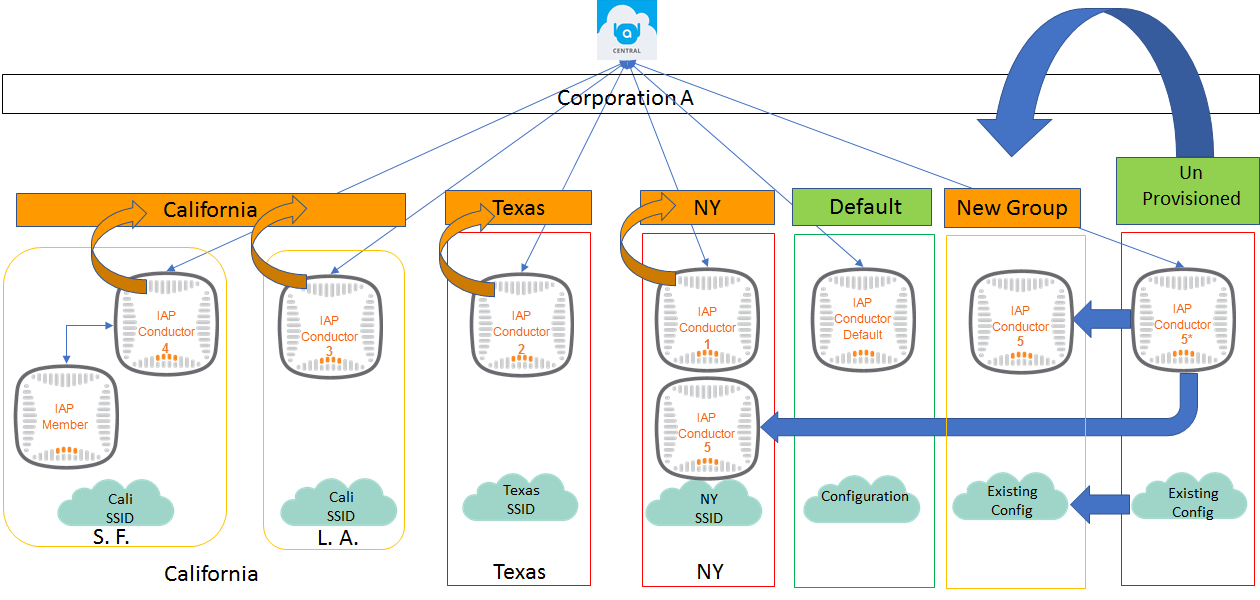Provisioning Devices Using UI-based Workflows
This section describes the important points to consider when assigning devices to UI groups:
- Provisioning APs using UI-based Configuration Method
- Provisioning Switches Using UI-based Configuration Method
Provisioning APs using UI-based Configuration Method
An AP device group may consist of any of the following:
- AP Cluster—Consists of a conductor AP and member APs in the same VLANVirtual Local Area Network. In computer networking, a single Layer 2 network may be partitioned to create multiple distinct broadcast domains, which are mutually isolated so that packets can only pass between them through one or more routers; such a domain is referred to as a Virtual Local Area Network, Virtual LAN, or VLAN..
- VC—A virtual controller. VC provides an interface for the entire cluster. The member APs and conductor APs function together to provide a virtual interface.
- Conductor AP and Member AP—In a typical AP deployment scenario, the first AP that comes up is elected as the conductor AP. All other APs joining the cluster function as the member APs. When a conductor AP is configured, the member APs download the configuration changes. The conductor AP may change as necessary from one device to another without impacting network performance.
Aruba Central (on-premises) allows configuration operations at the following levels for a device group with APs.
—Aruba Central (on-premises) allows you to maintain unique configuration settings for each group. However, these settings are applied to all devices within that group. For example, all VCs within a group can have common SSIDService Set Identifier. SSID is a name given to a WLAN and is used by the client to access a WLAN network. settings.
—Any changes that need to be applied at the AP cluster level can be configured on a VC within a group. For example, VCs within a group can have different VLAN configuration for the SSIDs.
—Although devices are assigned to a group, the users can maintain device-specific configuration such as radio, power, or uplink settings for an individual AP within a group.
When the APs that are not pre-provisioned to any group join Aruba Central (on-premises), they are assigned to groups based on their current configuration.
|
APs with Default Configuration |
APs with Non-Default Configuration |
|---|---|
|
If an AP with factory default configuration joins Aruba Central (on-premises), it is automatically assigned to the group or an existing group with similar configuration settings.
The administrators can perform any of the following actions:
|
If an AP with non-default or custom configuration joins Aruba Central (on-premises), it is automatically assigned to an group.
The administrators can perform any of the following actions:
|
Ensure that the conductor AP and member APs are assigned to the same group. You must convert the member AP to a standalone AP in order to move the member AP to another group independently
In the following illustration, APs from three different geographical locations are grouped under California, Texas, and New York states. Each state has unique SSIDs and can support devices from multiple locations in a state. As shown in Figure 1, the California group has devices from different locations and has the same SSID, while devices in the other states/groups have different SSIDs.
When a device with the factory default configuration connects to Aruba Central (on-premises), it is automatically assigned to the default group. If the device has a custom configuration, it is marked as unprovisioned. If you want to preserve the custom configuration, create a new group for the device. If you want to overwrite the custom configuration, you can assign the device to an existing group.

Provisioning Switches Using UI-based Configuration Method
Aruba Central (on-premises) allows switches to join UI groups only if the switches are running factory default configuration. Aruba Central (on-premises) assigns switches with a factory default configuration to the group.
The administrators can either move the switch to an existing group or create a new group.
Aruba Central (on-premises) does not support UI-based configuration workflows for Aruba 5400R Switch Series and switch stacks. Aruba recommends that you assign these devices to template groups and provision them using configuration templates
Aruba Central (on-premises) does not support moving Aruba 5400R Switch Series from the template group to a UI group. If Aruba 5400R Switch Series is pre-assigned to a UI group, the device is moved to an unprovisioned group after it joins Aruba Central (on-premises).
Aruba Central (on-premises) allows the following configuration operations at the following levels for switches in a UI group:
- — Aruba Central (on-premises) allows you to maintain unique configuration settings for each group. However, these settings are applied to all devices within that group. For example, all switches within a group can have common VLAN settings.
- —Although the Switches inherit group configuration, the users can maintain device-specific configuration, for example, ports or DHCPDynamic Host Configuration Protocol. A network protocol that enables a server to automatically assign an IP address to an IP-enabled device from a defined range of numbers configured for a given network. pools.

